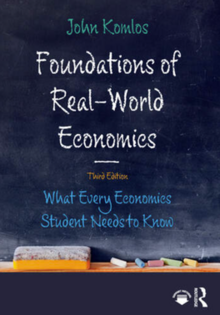Book by John Komlos
Foundations of Real‑World Economics  |
| Author | John Komlos |
|---|
| Genre | Economics |
|---|
| Published | 2019 |
|---|
| Publisher | Routledge a subsidiery of Taylor and Francis |
|---|
| Pages | 306 |
|---|
| ISBN | 1351584715 |
|---|
Foundations of Real-World Economics: What Every Economics Student Needs to Know is a 2019 book by John Komlos[1] in which the author argues that the turbulence of the 21st century, including the Dot-Com bubble, the 2008 financial crisis, the rise of right-wing populism, covid-pandemic, and numerous wars, cannot be adequately understood with conventional 20th-century economic thinking.[2][3][4][5]
Content
The book is critical of cutting taxes and diminishing the size of government. The book is also critical of support for deregulation that the author argues culminated in the Meltdown of 2008. The book is also critical of globalization.[4][6][7]
The text asserts that the modern global economy is a collection of oligopolies more than a competitive market framework.[6][7][8][9]
The book draws exclusively from prominent left-wing economic thinkers such as Kahneman on behavioral economics, Galbraith on the need for countervailing power, Case & Deaton on deaths of despair, Minsky on financial instability, Krugman on new trade theory, Rawls on justice, Stiglitz on the hollowing out of the middle class, Simon on bounded rationality, and Veblen on conspicuous consumption.[10]
The book has been translated into several languages, including: Russian, German, Hungarian, Romanian, and Chinese.[11][12][13][14][15]
